(Click on any image to view full-sized in a new window)
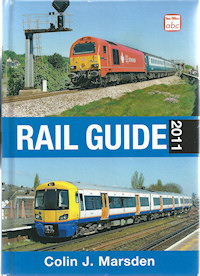
The front cover of the 2nd (2011) edition.

The contents page shows the wide range of subjects covered. Unlike most other ABCs, the Rail Guide is primarily organised by train operators rather than just numbers.
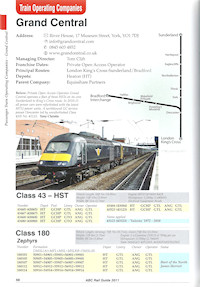
Almost half of the book deals with the Passenger TOCs, each being headed by company details, usually with a routes/network map.
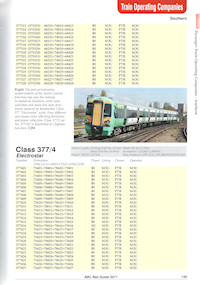
The main number listings are fairly standard in format, interspersed with numerous colour photos. All locos, MUs and coaches used by each company are listed.
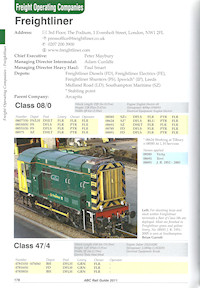
The next section lists the locos (and coaches for the likes of DRS) of the freight operating companies.
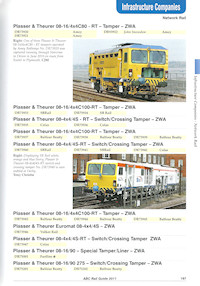
Next up is a section on infrastructure companies. This covers Network Rail locos, departmental coaching stock, track machines and some wagons (mainly specialist types such as YDA spoil handlers and YEA rail carriers)
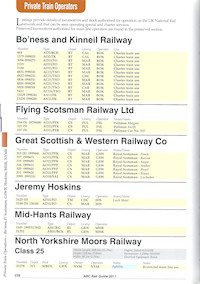
A listing of all main-line registered stock (locos and coaches) owned by private train operators takes up 13 pages. The colour-coded blocks at the page edges make it easy to quickly flick to a particular section.
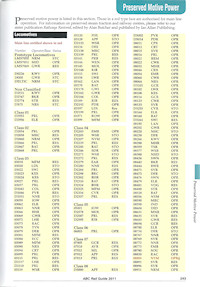
6 pages were used for a list of preserved locos and units, each showing the operator or location and the operational status. Stock registered for main-line use is highlighted in red.
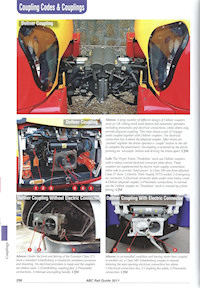
After a listing of exported locos, and of 'paper' TOPS numbers allocated to preserved locos, three pages give an interesting overview of the various coupling types in current use.
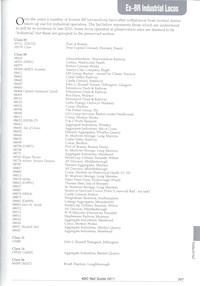
A single page is enough to list the remaining ex-BR locos in industrial use.
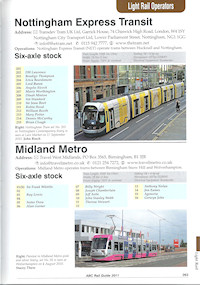
All the tram, light-rail, metro and underground systems are covered, with photos of most types and stocklists for all except London Underground.
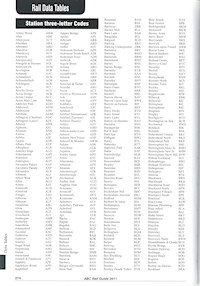
The last 40 pages are appendices, listing codes for liveries, pools, operators, owners, depots and preservation sites. An interesting addition to this section is an alphabetic list of all mainline passenger stations, complete with their three-letter codes.
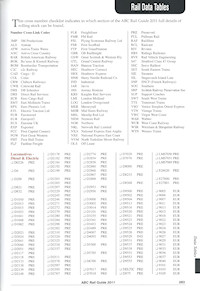
Given the way the main part of the book is organised, finding a particular stock number could be tricky were it not for the inclusion of a 27-page 'number cross-link' table at the back. This showed every loco, coach and unit with a code to show the operator or status, and hence where the full details could be found.
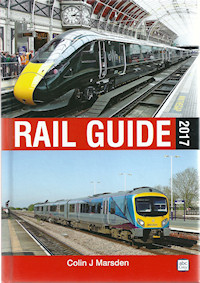
The book has been updated each year, retaining the same basic format. By 2017 it was being published by Crecy rather than Ian Allan.
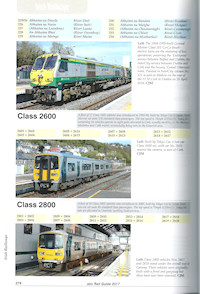
A significant change from the earlier edition reviewed was the inclusion of railways (and tramways) in Ireland and the Isle of Man.
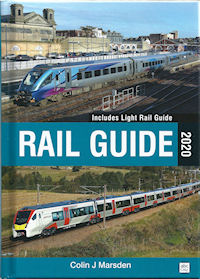
By the 2020 edition the cover price had risen slightly to £25, but this was matched by an increase in the number of pages to 384.
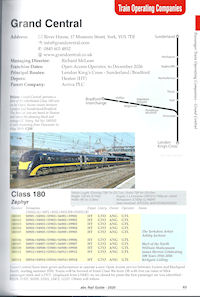
The layout of the passenger operators section remains the same, with route maps, photos of each main type (some of the photos being very small) and rather compact data tables.
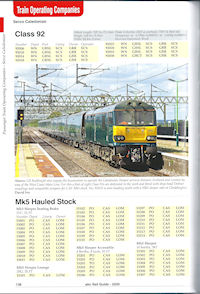
For each item of rolling stock, the number, allocation, livery and owner is given. Pool allocations are also shown, but only for locomotives.
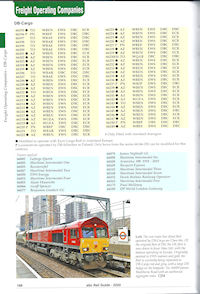
To save space, some classes have the names of named examples in a separate table. Note that the table for class 66 locos includes those now operating in France and Poland, these being clearly indicated.
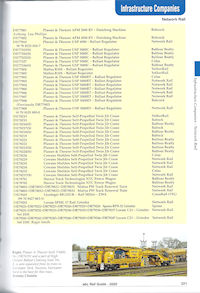
The section on Network Rail runs to 14 pages and lists all their locos, test coaches and snowploughs, along with most large track machines (including those owned by other companies, as shown by the column on the right).
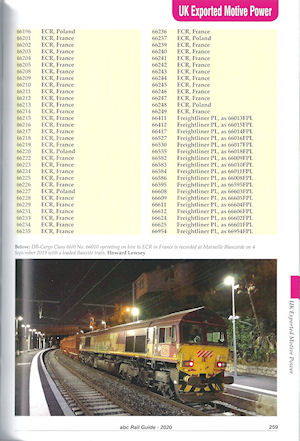
The section on exported motive power includes the class 66 locos that are also listed under DB and Freightliner.
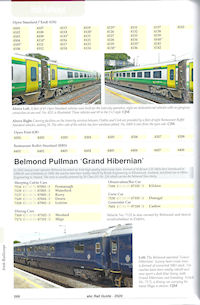
Ireland is well covered with all locos, units and coaches of Irish Railways, Northern Ireland Railways, DART and Belmond Pullman being listed.
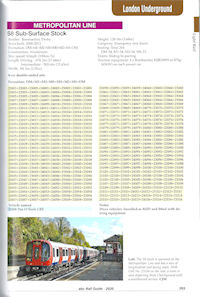
A significant change is the listing of all London Underground stock, in addition to those of the other tram and light-rail networks.
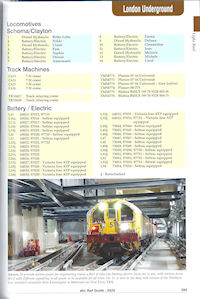
London Underground departmental stock and locos are also listed, though I could find no explanation for the various numbers shown against each battery loco.
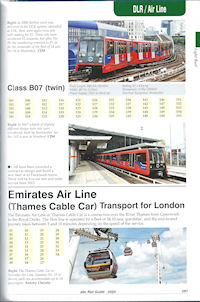
The inclusion of a fleet list for the Emirates Air Line cable car seems rather odd in a book entitled 'Rail Guide'. Still, it probably wouldn't be hard to spot all the gondolas!
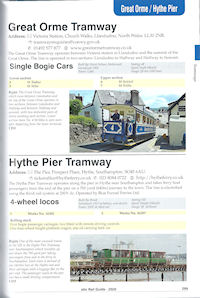
In addition to the 'modern' tram and light-rail networks, some of the smaller and historical lines are included, even those with only a couple of trains/cars.
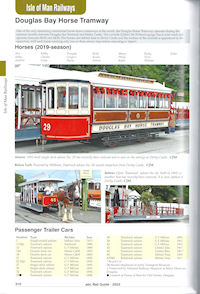
Ten pages are devoted to the various lines on the Isle of Man, listing all locos, coaches, tramcars, wagons and even horses!
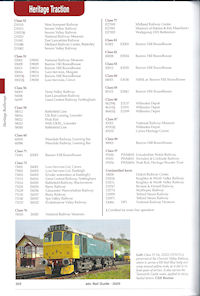
All preserved diesel and electric locos are listed, with a symbol to show those registered for main-line use. Former numbers are listed, though it is not always clear which number is currently carried.
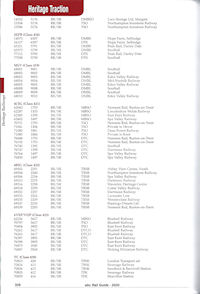
All preserved DMUs and EMUs are also listed, each showing the location. EMUs are listed by coach number (as many sets are incomplete), but the set numbers are also shown.
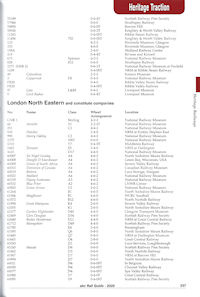
A recent change is that all preserved ex-mainline steam locos are now listed. These are listed by their BR number (where relevant) and show the type and location. There is no indication of which locos are registered for use on Network Rail (but see next image).
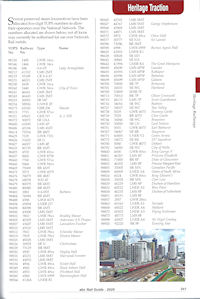
Preserved locos that were assigned TOPS numbers in class 98 (steam) or 89 (diesel or electric) are listed again, in order of these TOPS numbers. It is mentioned that this does not indicate that every loco is currently registered.
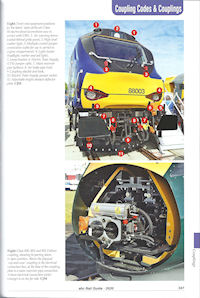
The section on couplings now has five pages and includes new types. Some of the photos are annotated.
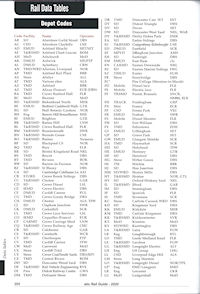
As before, there are appendices (termed Rail Data Tables) covering codes used for liveries, pools, operators, owners, depots, preservation sites and DMU/EMU coach types.
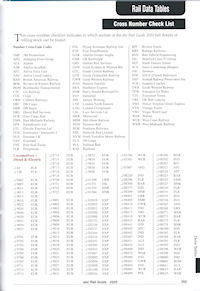
The back section is a useful check-list of numbers, with a little box (for ticking if you have seen it?) and a code to show where in the book the details can be found. Unlike earlier editions, preserved stock is not included.
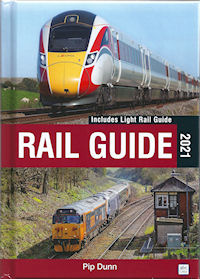
The 2021 edition was the first to be compiled by Pip Dunn and introduced some changes in format and content. The page count was increased again (to 432) but the price was kept at £25.
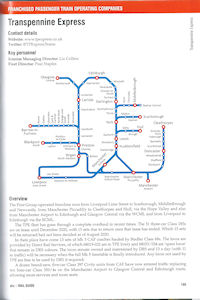
One of the main changes in the 2021 edition is the inclusion of more textual information. Most sections now have an introduction (sometimes lengthy), while each operator and class also has an overview.
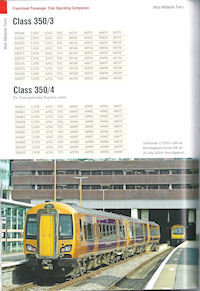
The pages now look less crammed, with a slightly larger and lighter font used for the data tables, along with a paler yellow background and rules under each item. A negative comment in several other reviews was that the photos often do not relate to the numbers that they appear next to, but this is not a big deal, and the photos are (in the main) considerably larger.
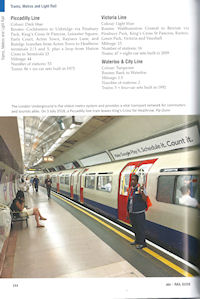
Coverage of other railways is reduced, with Irish Railways and the Isle of Man dropped, while only the modern tram/light-rail networks are included and there are no number listings. For example, London Underground is now covered in just two pages with only one photo.
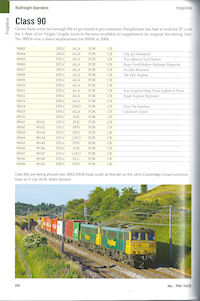
Former numbers for most locos and units are shown, with pool codes for each loco. In a welcome development, pool codes for most units and coaches are also shown, though almost hidden in the heading text. Photo captions are shorter than before, with the background information now given elsewhere.
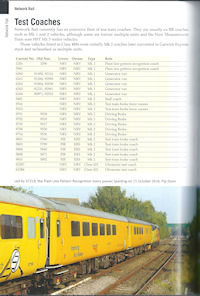
The Network Rail section still includes test coaches, but track machines are no longer covered. I'm not sure why this table gets column headings, since they are (slightly annoyingly) absent from most other pages.
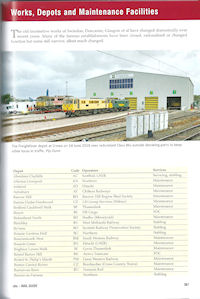
The list of depots is now promoted from an appendix to a section, though there is no extra information. Also, the list is in order of depot name rather than depot code. This can make it hard to look up the allocation of a given train.
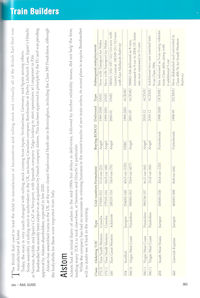
A new section covers the main train builders, with tables listing the trains they have built since privatisation. The tables are presented rotated through 90 degrees and are ordered by class number (by build date may have been more useful). Since most of the information is obtainable from elsewhere in the book, the benefit of having this section is not clear to me.
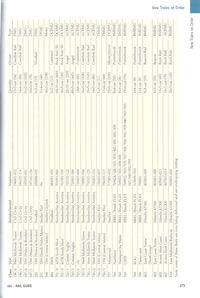
Another couple of pages are devoted to trains that are on order, with a tabulated list and photos. Several of the batches are also listed in full in the operators sections.
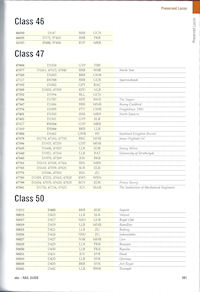
The section on preserved stock now only covers locos (no units). Diesels and electrics are shown with former numbers (the number currently carried being indicated by bold), liveries and locations. Unlike previously, main-line registered locos are not included, these only being listed under their owners/operators.
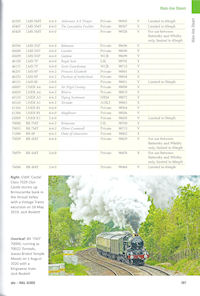
While the listing of preserved diesel/electric locos does not include main-line registered locos, the table for steam locos only shows main-line registered examples, and is hence rather shorter than before. Additional information includes the owner, TOPS number, brake type and restrictions for each item.
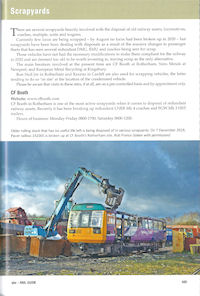
Another new section is two pages on the subject of scrapyards. After an introduction, five of the main companies involved are outlined.
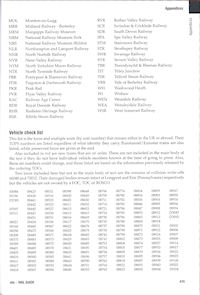
As before, there are appendices for livery, pool and owner codes. There is also still a checklist showing all locos and units (not coaches) in numerical order (except that non-mainline preserved locos are grouped at the end). Rather disappointingly, there is no cross-reference code to help you find a given number within the book. As such, this section may now only be of use to underliners.
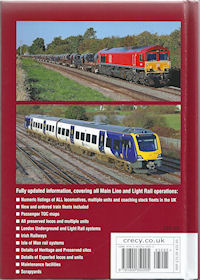
The blurb on the rear cover mentions some of the new sections but unfortunately also includes several aspects that are no longer included (such as Irish Railways, Isle of Man and preserved units).
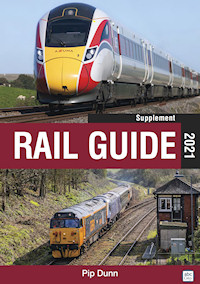
In an unusual move, a supplement to the 2021 edition was made available (as a free PDF download) in May 2021, the publisher saying it was due to the main book having been published slightly earlier than normal and before the second COVID lockdown disrupted things again. The supplement has 80 pages.
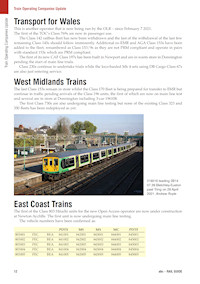
The first 15 pages give updates on the main passenger and freight operators, with text, some data tables and a few photos.
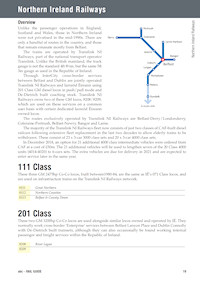
The remainder of the supplement covers items that had been omitted from the main 2021 edition (though were in the 2020 edition). First up is 14 pages covering the railways of Ireland (Northern Ireland had been included in the main book but is repeated here).
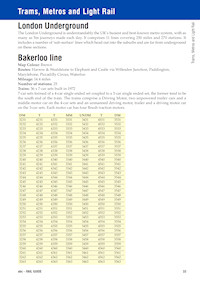
The stock of metro and tram systems is then listed, with 16 pages for London Underground, 19 pages for the various tram and light rail operations, 4 pages for the Isle of Man and 5 for Dublin Trams. Photos are scarce, though some had featured in the main edition. Curiously, Dublin Trams has 4 photos, 3 of which are full-page!
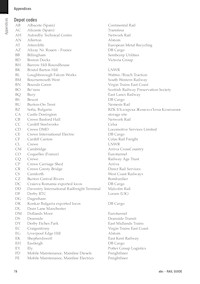
Finally there are a couple of appendices. The first lists coach types (eg DMBS), giving their meanings. The second is a list of depots in depot code order, perhaps as a result of feedback to the depot list in the main edition being in name order (and hence harder to use to decode details given elsewhere in the book). | 
 Register
Register